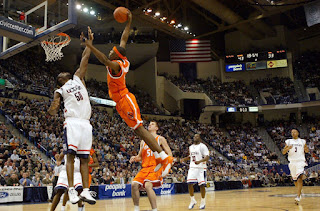In 2007, OrangeHoops inducted its charter class into the OrangeHoops Hall of Fame: Dave Bing, Derrick Coleman, Sherman Douglas, Vic Hanson, and Pearl Washington. The next several years saw the addition of Billy Owens (2008), Billy Gabor (2009), Lawrence Moten (2010), Louis Orr (2011), Roosevelt Bouie (2011) John Wallace (2012), Rony Seikaly (2013), Vinnie Cohen (2014), Etan Thomas (2015), Joe Schwarzer (2016), Lew Andreas (2017), Carmelo Anthony (2018), Stephen Thompson (2019), Hakim Warrick (2020), Gerry McNamara (2021), and Rudy Hackett (2022). So the list now stands at 22. Another year has passed, and now it is time for the 2024 inductee.
Friday, November 29, 2024
OrangeHoops Hall of Fame 2024
Wednesday, September 20, 2023
OrangeHoops Hall of Fame 2023
In 2007, OrangeHoops inducted its charter class into the OrangeHoops Hall of Fame: Dave Bing, Derrick Coleman, Sherman Douglas, Vic Hanson, and Pearl Washington. The next several years saw the addition of Billy Owens (2008), Billy Gabor (2009), Lawrence Moten (2010), Louis Orr (2011), Roosevelt Bouie (2011) John Wallace (2012), Rony Seikaly (2013), Vinnie Cohen (2014), Etan Thomas (2015), Joe Schwarzer (2016), Lew Andreas (2017), Carmelo Anthony (2018), Stephen Thompson (2019), Hakim Warrick (2020), Gerry McNamara (2021), and Rudy Hackett (2022). So the list now stands at 21. Another year has passed, and now it is time for the 2023 inductee.
DuVal was a flashy point guard for Syracuse in the early 70s. When he graduated from Syracuse he was only second to Dave Bing in career points scored. He was a three year started and averaged 18.6 ppg. DuVal was a third team All-American his senior year
Addison was gaining a reputation as being one of the most underrated players in the country his junior season, again leading the Orange in scoring with 18.4 ppg. He would earn All Big East First Team recognition his junior year.
Saturday, October 01, 2022
OrangeHoops Hall of Fame 2022
In 2007, OrangeHoops inducted its charter class into the OrangeHoops Hall of Fame: Dave Bing, Derrick Coleman, Sherman Douglas, Vic Hanson, and Pearl Washington. The next ten years saw the addition of Billy Owens (2008), Billy Gabor (2009), Lawrence Moten (2010), Louis Orr (2011), Roosevelt Bouie (2011) John Wallace (2012), Rony Seikaly (2013), Vinnie Cohen (2014), Etan Thomas (2015), Joe Schwarzer (2016), Lew Andreas (2017), Carmelo Anthony (2018), Stephen Thompson (2019), Hakim Warrick (2020), and Gerry McNamara (2021). So the list now stands at 20. Another year has passed, and now it is time for the 2022 inductee.
DuVal was a flashy point guard for Syracuse in the early 70s. When he graduated from Syracuse he was only second to Dave Bing in career points scored. He was a three year started and averaged 18.6 ppg. DuVal was a third team All-American his senior year
Hackett averaged 22.2 ppg and 12.7 rebounds per game his senior year to help lead the Orangemen to their first Final Four as a Cinderella underdog. He and Jimmy Lee were the Orangemen's one-two punch during their improbable run in the NCAA tournament.
Wednesday, September 29, 2021
OrangeHoops Hall of Fame 2021
In 2007, OrangeHoops inducted its charter class into the OrangeHoops Hall of Fame: Dave Bing, Derrick Coleman, Sherman Douglas, Vic Hanson, and Pearl Washington. The next ten years saw the addition of Billy Owens (2008), Billy Gabor (2009), Lawrence Moten (2010), Louis Orr (2011), Roosevelt Bouie (2011) John Wallace (2012), Rony Seikaly (2013), Vinnie Cohen (2014), Etan Thomas (2015), Joe Schwarzer (2016), Lew Andreas (2017), Carmelo Anthony (2018), Stephen Thompson (2019), and Hakim Warrick (2020). So the list now stands at 19. Another year has passed, and now it is time for the 2021 inductee.
DuVal was a flashy point guard for Syracuse in the early 70s. When he graduated from Syracuse he was only second to Dave Bing in career points scored. He was a three year started and averaged 18.6 ppg. DuVal was a third team All-American his senior year
Sunday, October 18, 2020
OrangeHoops Hall of Fame 2020
In 2007, OrangeHoops inducted its charter class into the OrangeHoops Hall of Fame: Dave Bing, Derrick Coleman, Sherman Douglas, Vic Hanson, and Pearl Washington. The next ten years saw the addition of Billy Owens (2008), Billy Gabor (2009), Lawrence Moten (2010), Louis Orr (2011), Roosevelt Bouie (2011) John Wallace (2012), Rony Seikaly (2013), Vinnie Cohen (2014), Etan Thomas (2015), Joe Schwarzer (2016), Lew Andreas (2017), Carmelo Anthony (2018) and Stephen Thompson (2019). So the list now stands at 18. Another year has passed, and now it is time for the 2020 inductee.
DuVal was a flashy point guard for Syracuse in the early 70s. When he graduated from Syracuse he was only second to Dave Bing in career points scored. He was a three year started and averaged 18.6 ppg. DuVal was a third team All-American his senior year
Warrick, as mentioned above, was highly accoladed while at Syracuse. He would by drafted 19th overall in the 2005 NBA draft and have a solid eight yera NBA career, primarily with Memphis. He thrilled Syracuse fans with his breathtaking dunks for four seasons, and of course was a vital part of the National Championship.







